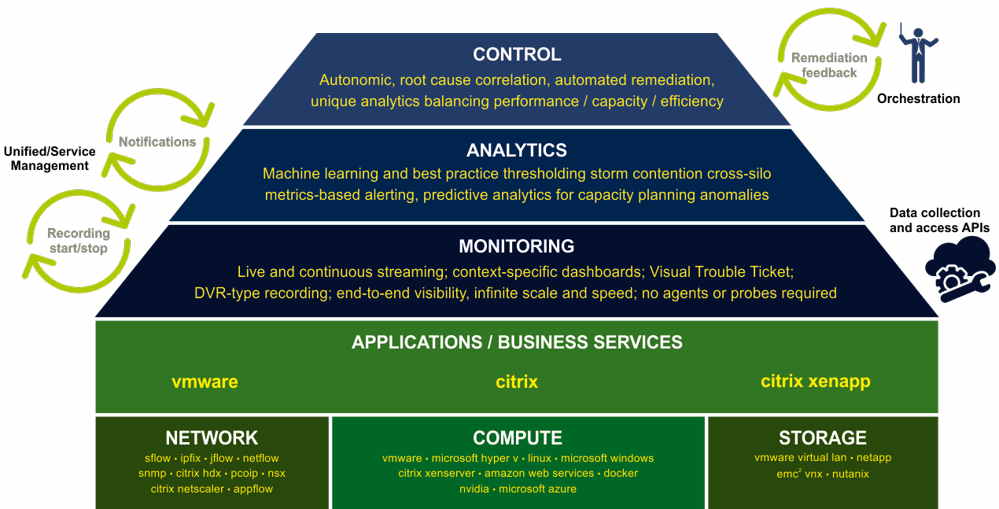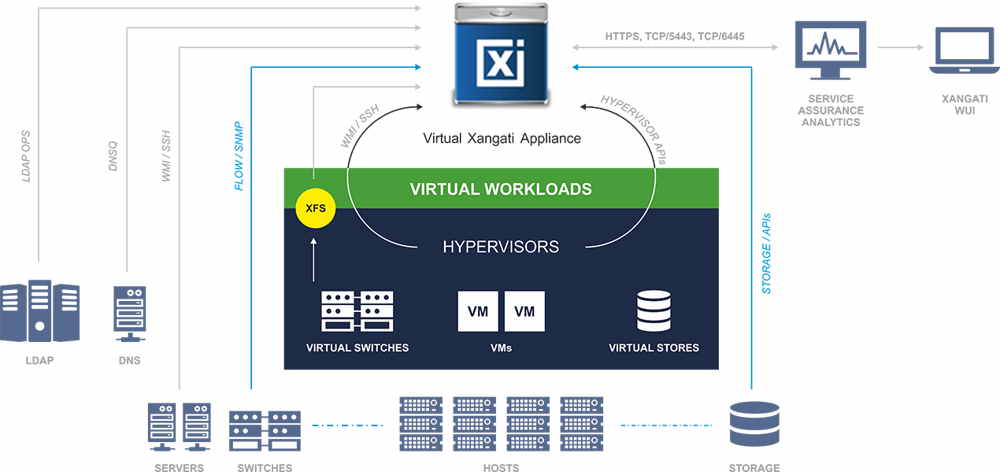Xangati: Next-Gen Performance Management and Control Platform
For optimizing hybrid cloud infrastructures
This is a Press Release edited by StorageNewsletter.com on April 21, 2016 at 2:47 pmXangati, Inc. announced a next-generation service assurance analytics and performance control platform, ESP for Cloud Workspace and Cloud Infrastructure, with self-healing support for new compute environments, new storage and networking data sources, and enhanced visibility into end-user metrics, spanning a range of software-dashboard modules for Virtual Infrastructure, VDI and Virtual Applications.
The ESP platform, a virtual appliance built on a common in-memory architecture that visualizes performance data with unprecedented speed and scale across multiple software-dashboard modules, crunches hundreds of thousands of interactions live, second-by-second, without the use of agents or probes, to enable predictive analytics based on dynamic threshold algorithms and machine-learned heuristics that determine acceptable service levels for:
-
Performance: How fast is the infrastructure or platform running applications, and what impacts are there to the end-user experience
-
Efficiency: How well-utilized is the infrastructure or platform
-
Capacity: When does the infrastructure or platform need to be expanded to meet application needs to drive greater operations agility and productivity
-
Availability: Is the infrastructure or platform accessible/usable/active to mitigate risk to business disruptions or threat-related pattern anomalies
-
Cost: What are the right-sized IT investments to support the enterprise KPI’s and infrastructure ROI goals, and reasonable business outcomes
The company launched four ESP extensions to its best-in-class monitoring solution: Nvidia Corporation, ‘ physical GPU, Amazon Web Services (AWS), Microsoft Azure and Docker, in which company’s virtual appliance software correlates real-time data across on-premise virtualization, containers and public clouds.
The ESP Extension for NVIDIA pGPU empowers cloud workspace system administrators with deep visibility into the performance of XenServer’s hypervisor pGPU utilization. Sysadmins can now optimize their pGPU resources by visualizing per-VM and%age utilization metrics of pGPU, memory and frame buffers, and ensure optimal performance for VDI graphics acceleration.
The extensions for AWS, Azure and Docker are subscription licenses stackable on top of a required license for the core ESP for Cloud Infrastructure platform. The AWS and Azure Extensions analyze CPU, memory and storage utilization of an organization’s VMs and associated objects, and Virtual Private cloud VMs hosted in an AWS or Azure account.
In a classic hybrid-cloud infrastructure, any VM can be a Docker-container host if the proper credentials to collect data are granted, such as for micro-services that execute one service or app (each Docker host consists of containers and images supporting a business service). The ESP Extension for Docker tracks and correlates metrics for containers and images so that they can be profiled and alerted upon within the overall context of end-to-end visibility and performance control services provided by Xangati.
From a networking perspective, the firm is adding a new index for pattern anomalies, including end-user behavioral metrics that are correlated and analyzed across the spectrum of ESP modules and extensions:
-
Measures unusual or suspicious activity associated with VMs, services and hosts
-
Screens for anomalous interactions such as ‘affinity counts,’ or the number of objects the anomaly index is interacting with; such anomalous interactions typically indicate potential security breaches (malware, DDoS, SpamBots, Data Leakage/Privacy)
-
Comparison analysis benefits: The anomaly index is another useful source of threat intelligence for hybrid-cloud environments whereby data protection, data privacy and HA are always top priorities.
Additional net features and functionality to ESP platform are:
-
ESP extension for EMC VNX: Integration into EMC Corp.‘ VNX storage pools that reports the IO/s, throughput and latency metrics that VNX is contributing to the hypervisors (file, block, unified). Additionally, data on NFS or CIFS shares, iSCSI or FC LUNs and CPU utilization and overall network bit-rates are collected.
-
ESP storage module: Designed for the storage infrastructure and virtual storage objects, the company collects metrics on the IO/s, throughput and latency of each datastore as well as the number of hypervisors and guest VMs using each. Xangati monitors the choke-points for storage systems, typically the network interfaces through which storage talks to the controllers that perform R/W transactions, the disks’ ability to deliver I/O, and/or the flash memory’s ability to cache and deliver I/O.
-
Control enhancements of automated contention-storm analysis including for efficiency (alert driven remediation to avoid degrading conditions, and storm-driven remediation) and for prescriptive remediation actions (migration, modify memory or CPU, scale up or down, power off or on).
-
Live visibility and on-demand insights of Citrix Systems, Inc.‘ XenApp/XenDesktop and Vmware, Inc.‘ Horizon availability and performance VDI metrics
-
Device-independent, app-driven Visual Trouble Ticket capability
“Enterprises are focused on progressing their hybrid-cloud strategies; Xangati helps mitigate migration risk with its next-gen platform by extending its real-time performance analytics and IT efficiency solution beyond on-prem orthodoxies to include the two most popular public cloud resources, the predominant containerization standard, and several new data sources and analytics indices to create even greater gravity around one management console that assures service delivery quality and self-healing functions for virtual apps across conventional infrastructure silos,” said Atchison Frazer, CMO, Xangati.
















 Subscribe to our free daily newsletter
Subscribe to our free daily newsletter

